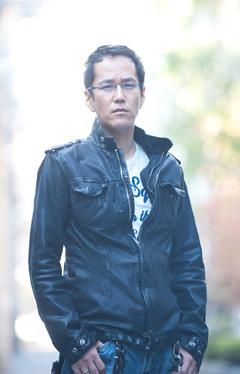Interview with Kenji Kamiyama (4)
 | Kenji Kamiyama Born in Saitama Prefecture on March 20, 1966. A rare example of a background artist shifting to directorial roles, Kamiyama became a protégé of Mamoru Oshii, working as animation director in Jin-Roh: The Wolf Brigade (1999) and contributing the script for Blood: The Last Vampire (2000). International attention arrived with the TV series Ghost in the Shell: Stand Alone Complex (2002, Excellence Prize, Japan Media Arts Festival 2002) and its second season, Ghost in the Shell: S.A.C. 2nd Gig (2004), followed by the feature-length Ghost in the Shell: Stand Alone Complex - Solid State Society (Jury Prize, 21st Digital Content Grand Prix). In 2007, after almost 6 years spent in the world of Ghost in the Shell, Kamiyama directed the high-fantasy TV series Moribito: Guardian of the Spirit (Jury Recommended Work, 11th Japan Media Arts Festival) followed in 2009 by Eden of the East (2009, Best TV Animation, 14th Animation Kobe), Kamiyama's highly anticipated original TV series, dealing with NEETs and other underlying issues in Japan's youth society. In 2011, he supervised the 3D conversion of Ghost in the Shell: Stand Alone Complex - Solid State Society, that was greeted with the International 3D Award at the 1st International 3D Awards 2011. |
Re:Cyborg, 27 Years Later - PART 4
Let's talk a bit about the technical side of the project. This movie is done in full CG, which is still unusual for Japan. And it is in stereoscopic 3D, which is even more exceptional.
I have been always advocating a more substantial introduction of computer-generated animation in this country. 009 Re:Cyborg is the natural evolution of a short film Oshii directed a few years ago, and it was meant to be in 3D from the very beginning. Hand-drawn animation, which is the prevalent technique used in Japanese productions, doesn't match well with stereoscopic cinema, simply because you have to film in traditional 2D and then convert into 3D. The only way to create native 3D images is to work with the computer from the very beginning, so I had a good opportunity to experiment. The result is a 2D-looking stereoscopic 3D full CG animated film. I think nobody has ever tried that before.
The characters look more like traditional 2D cell animation.
I do not consider the computer as a replacement to hand-drawn animation, but as a tool that help us to expand the potentials of what can be achieved on screen. I wanted to keep the distinctiveness of Japanese animation in terms of visual rendering, and I was not interested in pursuing photorealistic effects or reproducing every single and subtle human movement relying on massive use of motion capture. We followed, if possible the opposite approach, subtracting instead of adding information. With CG animation you can have 24 different images every second, the same rate of live action filming. But for this film, we reduced them to 8 per second, which is the standard in traditional 2D hand-drawn animation.
Wasn't the staff puzzled at such request?
Let's say that when I explained to the animators that I wanted a hand-drawn feel to the animation, each of the CG staff interpreted this directive their own way. I had to start with a lecture about the rules I had been following in making animation. You start from very basic things, for example the number of different frames used to render lips movement when a character talks.
What advantages did you find in using 3D CG?
The biggest advantage is indeed the fact that with CG you can correct and modify much easier and quicker than in hand-drawn animation. Another cool thing is that you can test different camera movements, lights and lenses, a kind of luxury you definitely cannot afford otherwise. Same for the characters' acting. For this reason, there's more interaction between the director and the animators. With hand-drawn animation, usually there's only one general meeting with the animators at the very beginning, then the rendering is very much up to each individual. This time I sat with the animators in front of the monitor and discussed with them the best thing to do. I think it was much more fulfilling for both.
How about disadvantages, if any?
Well, it was something I discovered this time, but... in 2D you prepare the main design sheet, and then the animators just follow them. In 3D you have to create the model for each single prop appearing on screen.
Do you have a message for the fans?
Remakes of popular properties tend to be negatively perceived by the audience a priori. However, I believe that the original reinterpretation of classic characters is steadily establishing itself as an important component of today's popular culture. It is my hope that this 009 Re:Cyborg could stand as the first of many future projects related to the 00-series cyborgs.
(4 - end)
© 2012 009 RE:CYBORG Production Committee

![WORK LIST[DETAILS]](/contents/works/design/images/left_title.gif)



 terms of use
terms of use